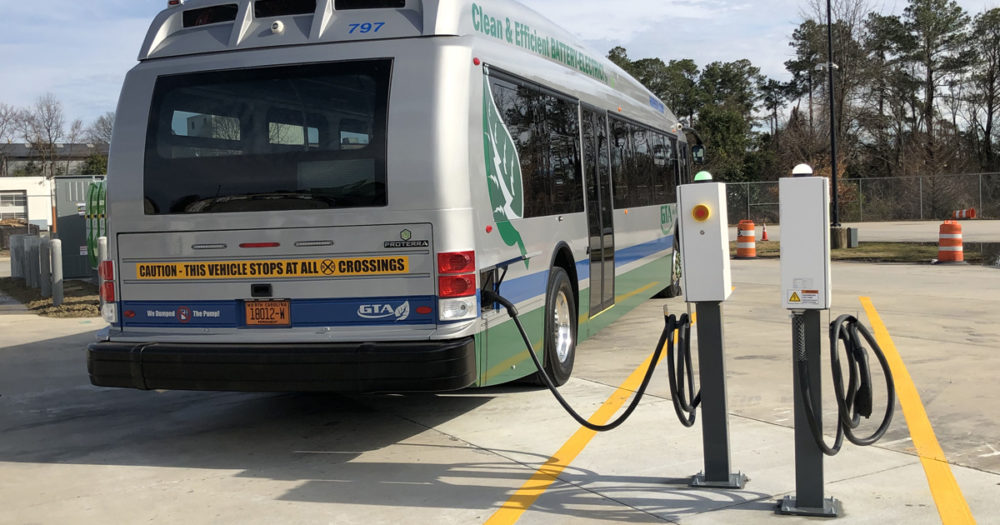Today, in my inaugural blog post, I am excited to share a set of recommendations for electric utility investments in electric truck and bus charging programs.
Swapping diesel trucks and buses for electric models is a critical strategy for both reducing greenhouse gas emissions to mitigate climate change and reducing local air pollution to improve public health. The good news is that high-performance electric trucks and buses are becoming increasingly available for many vehicle uses, notably medium-duty delivery vehicles, cargo equipment, transit buses, and school buses. The challenge is that widespread deployment of those vehicles requires a large-scale, coordinated effort by policymakers, private investors, and—you guessed it—electric utilities.
For their part, electric utilities are an important early investor in charging programs for all EVs, including trucks and buses for several reasons. First, grid-related investments to support electricity demand from EVs are well within utilities’ wheelhouse. Second, utilities’ expertise in managing the grid make them an important partner in managing electric truck and bus loads to maximize potential benefits to the grid. For example, smart charging of EVs can make renewable energy easier to incorporate into the grid. Finally, utilities have access to debt and capital to make investments that kick-start the comparative market for private investments.
Utilities across the country are starting to take a serious look at EV programs to support the growing demand for electric cars, trucks, and buses. Many utilities are moving forward with vehicle electrification proposals to state utility regulators, some of which include consideration for heavy-duty vehicles. Proactive state regulators and electric utilities can take advantage of the growing availability of models to accelerate electric truck and bus deployment to help realize the health, climate, and grid benefits from medium and heavy-duty vehicles.
UCS has laid out the principles for how electric utilities should invest in EV charging. The recommendations we release today, Utility Investment in Truck and Bus Charging: A Guide for Utilities, build on those principles by providing high-level guidance on the design of utility programs for truck and bus charging.
How should utilities go about designing programs, and what should state regulators look for when evaluating programs?
Consider various strategies to address barriers to truck and bus charging.
Different electric truck and bus uses may require different program strategies, depending on vehicle model availability and the business case for electrification in a specific service territory. For charging infrastructure, this means utilities may need to make use of a variety of ownership models in order to effectively accelerate EV deployment. These ownership models extend beyond “business as usual” up to “end-to-end” utility ownership from the customer meter to the charger (see figure).
Set fair commercial rates that account for truck and bus charging and provide incentives for grid services.
Operating costs are one of the most important factors vehicle operators, particularly those who operate fleets, consider when deciding whether to switch to electric models. Fair, sensible rates for commercial EV charging will ensure that vehicle operators have an opportunity to save on fuel costs and provide an incentive for charging at beneficial times for the electric grid.
Scale up programs based on their potential impact and the readiness of vehicles for electrification.
Vehicle applications such as transit buses, medium-duty delivery trucks, and cargo equipment have the potential to positively impact climate emissions and public health and are highly ready for electrification. As such, those vehicles are ready for large-scale utility programs. Utilities can also advance more nascent vehicle applications through pilot projects.
Prioritize serving communities overburdened by air pollution.
Diesel pollution and the consequential human health impacts are not distributed uniformly. Utility programs can have maximum impact for each charger deployed by focusing on areas that suffer disproportionately large amounts of diesel pollution. However, prioritizing overburdened communities is not just a best practice for cost-effectiveness. Because low-income communities and communities of color are overrepresented in overburdened areas, prioritizing charger and EV deployment in these areas is an important way to reduce public health inequities.
Coordinate and leverage multiple funding sources.
While utilities are well-suited to be an early investor in the EV charging space, other funds for EV charging are available. As UCS has previously discussed, the VW settlement and other funds fall short of providing the scale of investment needed for widespread electrification of truck and buses. Even so, those funds are an important resource for accelerating EV adoption. Utilities can maximize the reach of their own programs by coordinating with and leveraging other funding sources.
Consider fleet programs that accelerate electrification across vehicles classes.
Utilities can identify opportunities to include trucks and buses alongside passenger vehicles in fleet programs to make the most of synergies in information sharing between the utility and fleet customers.
Consult with truck and bus fleet managers when developing programs.
Utilities’ customer relationships with fleet managers can become strategic partnerships for the development of utility charging programs. Utilities can collaborate with fleet operators to understand the use and charging needs of electric trucks and buses in order to inform infrastructure programs and rate designs.
Set minimum charging system capabilities to enable managed charging.
Managed charging of truck and bus loads is critical to realizing the greenhouse gas benefits and fuel cost savings those vehicles can offer. A “smart” system in which chargers can communicate with a network system is necessary to enable managed charging. Requiring such capabilities for chargers supported by utility programs will enable managed charging, while also making it easier to upgrade charger software over time.
Future-proof investments by preparing charger sites for additional deployments.
It is important to take a long-term view of electric truck and bus deployment when designing programs. Utilities can future-proof “make-ready” investments—the upgraded panels, new conduit and wires to make the site ready for chargers—by considering expected future charging demand when determining the capacity of the make-ready installation.
I am encouraged to see some utilities already step up to support truck and bus electrification. We need many more to follow suit with significant investments to make timely progress on climate and public health. These recommendations will help make utility investments more effective in meeting these urgent goals.
For a fuller discussion of each recommendation, including program examples, be sure to check out the full policy brief.


